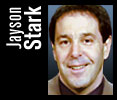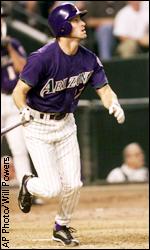|
|
|
|
 |
| ||
|
Scores Schedules Standings Statistics Transactions Injuries: AL | NL Players Weekly Lineup Message Board Minor Leagues MLB Stat Search Clubhouses | ||
| Sport Sections | ||
|
| ||
| TODAY: Monday, May 15 | ||||||||||||
| Homers, homers, homers ESPN.com | ||||||||||||
As far as we know, no new home run records have been broken in the last
30 seconds. But it's possible it's just a baud-rate problem.
Please have your seat back in the full upright and locked position before you read them: We polled a panel of 10 players, managers and scouts. They had plenty of theories. Here they come, in descending order of votes they got: Stronger hitters. Livelier ball. Harder ball. Miniaturized strike zone. Expansion and/or lack of enough decent pitchers. Ready for more? Here goes. Baseball wants it this way. The art of pitching inside is dying. No seams on the ball. Pitchers get paid whether they succeed or not. Better hitters. Not enough change-ups. El Niño. Solar flares. And even ESPN (for instilling fear in the pitchers). So which of those is it? Yes. In other words, all of them. We can't run through every explanation. Besides, there are links here to more detailed looks at all of the biggies. But here are some of our favorite theories: Stronger hitters: "Hitters don't look like they did when I came up," says veteran Diamondbacks reliever Dan Plesac, who reached the big leagues in 1986. "If somebody walked in a major-league clubhouse now and saw these guys out of uniform, they'd say, 'These guys look like linebackers in the NFL.' And not just the first basemen, the third basemen and the outfielders (as well). The middle infielders are 6-4, 215. But what can we do as pitchers? I could go in the weight room for five months in the offseason, and it won't make me any better a pitcher." Rocketballs: "It's the ball," says Padres coach Tim Flannery. "We were in Montreal last week, and when I broke in, in 1980, if you hit the wall there or hit one home run, it was something. This year, we had five monster blasts in one game, and balls were going well over the bleachers. If this keeps up, (Ryan) Klesko is going to kill someone. He knocked (Jose) Vidro down at second base with a line drive, flipped him on his back. The ball is going farther, because it's wound tighter." Harder balls: "I've spoken at length with these Hall of Famers," says Phillies ace Curt Schilling. "Steve Carlton, Bob Gibson, Robin Roberts, Jim Palmer. To a man, they all have commented on how incredibly hard the baseball is these days. Rawlings says it's not so, so everyone says, 'OK,' and looks elsewhere. But all of those pitchers said that when they pitched, you could physically move the leather on a baseball -- 'wrinkle it,' was the term they used. The baseballs we use are like pool balls, hard as a rock. This, in my opinion, is a very significant factor in the increase in home runs."
The world won't end if every baseball game winds up 14-11, with eight homers. The only trouble is, the games won't end, either. Not before Conan O'Brien, anyway. So what should baseball do? A) Hire more accountants and count the money? B) Hire more statisticians and count the homers? C) Raise the mound? D) lower Colorado? We got lots of suggestions on this topic, too. They included: Fix the strike zone. Raise the mound. Push back the fences. Kill the DH. Bring in extra gravity. And many variations of: Adjust to the times. Bigger strike zone: "For some reason, the strike zone has shrunk," Schilling says. "Hey, I watch ESPN every single night. I see the highlights. The strike zones are smaller. Anyone can see that. Smaller strike zones equate to less plate to cover for hitters, who can now narrow their zone to a much smaller area, and voila! More solid contact, more home runs." Raise the mound: "It's the only fair thing to do," Plesac says. "If they're going to bring the fences in, make the parks smaller and have every innovation help the offense, that's the one thing they can do to help the pitchers. Of course, Randy Johnson and Pedro could pitch from second base and still get guys out. I was watching Randy the other night, and I said, 'See, this game's not hard. Just be 6-10 and throw 97 on the black on both sides of the plate.' But not everyone can do that." Ban the DH: One player, who wishes to remain anonymous, says he can't see what purpose the DH serves anymore. "Nothing like the DH exists in any other sport," he says. "Imagine having somebody come onto the basketball court just to shoot Shaq's free throws just because he can't shoot them. That's what baseball does. Just because the pitcher can't hit, you have somebody else come off the bench and hit. But part of the joy of watching the game is saying, 'I can shoot free throws better than Shaq.' Or, 'I can hit better than that pitcher.' " Import gravity: "Pump pseudo gravity (PG) into every stadium, kind of like putting weights on every baseball," says Glanville, drawing once more on those physics classes at Penn. "They could say, 'The PG stopped that ball from going out.' Announcers would love it. Fans would have to go through gravity-adjustment training, but that would be part of the fun. Just don't drop your hot dog on your foot." But we can assure you baseball has no plans to bring in the physics professors. And if the pitchers are waiting for any other assistance, the commissioner suggests they might have a long wait. "I don't like adjusting rules or changing rules," says Bud Selig. "I know we did it in '68 or '69, but I'd rather not do that. And I certainly don't want to do it on the basis of the first couple of weeks of the season." So Selig's message to everyone is: Adjust. And he's right. If this is what the game is now, then teams ought to be mulling what's the best way to survive in this crazy new world. Good for the game? Or bad? Phillies manager Terry Francona says that the more he watches all kinds of hitters -- good and bad -- earning a living on pitchers' mistakes, the more "I continue to believe that (building around) very good pitching is the way to win." And will we ever see track teams like those mid-'80s Cardinals anymore? Why would we, wonders Flannery, "when anyone, anytime, can hit an opposite-field home run." It is even changing the way he coaches third, he says -- "because why, with two outs, would you try to jam a runner home, and take the chance we usually do with two outs, when you would only get one run if he is safe? The next guy might hit a three-run home run. The big innings are now what this game is all about." Ah, but is that good or bad? Well, we're glad we asked ourselves that. Because, ultimately, the fundamental question here is ... IS IT GOOD OR BAD? Schilling wonders: "Do fans want the game 14-10? I honestly don't believe they do. They want major league baseball. And that ain't major league baseball." But the record attendances say otherwise. And the Sammy and Mac Show of '98 -- covered by everyone from Rolling Stone to Regis and Kathy Lee -- said otherwise. "Today's society is a visual one," says veteran scout Gordon Lakey. "They don't have the patience to watch a 1-0 shutout." "The game ain't better," says Tigers closer Todd Jones. "It's just different. Fans like it, so they keep doing it." The conspiracy theorists are out there, naturally -- the people who think Bud and his cohorts sneaked into a lab after the strike and designed all this as their master plan to save baseball. To that, the commish says: "Was this some pre-ordained plan? Absolutely not." But Selig also says: "I think, for the most part, fans enjoy this. I don't think there's any doubt about that." So why, ultimately, would he want to mess with something that most fans enjoy? "What should the game do about this? Nothing," says a pitcher who asked not to be named. "This game is for entertainment purposes. Our job is to make it enjoyable for the fans. I think people would much rather see Big Mac hit than Maddux pitch. I wouldn't. But that's just me." Life is about change. Nothing in life stays the same. Nothing in sports stays the same. Baseball may be the most traditional sport on the planet. But that doesn't mean it should stay the same, either. Face it, friends. They're not going to blow up these new ballparks and redesign them. They're not going to shrink the hitters. They're not going to use modern science to bring in that pseudo-gravity or clone Pedro Martinez. So this is reality. This is baseball in the 21st century. So we'd urge the powers that be to call more strikes, start the games earlier and ban steroids. We'd urge the pitchers to learn the fine art of inducing more ground balls. We'd urge the hitters and the coaching staffs to remember that there's more to the essence of baseball than waiting around for the home run. We'd urge the number crunchers to point out more frequently that a 20-homer man now isn't what a 20-homer man used to be. And we'd urge broadcasters everywhere to come up with as many new home run calls as possible. Jayson Stark is a senior writer at ESPN.com. | ALSO SEE Home run theories Off Base: Carnage out of control Users sound off on all the home runs AUDIO/VIDEO   ESPN's Jayson Stark talks about this year's home run craze. ESPN's Jayson Stark talks about this year's home run craze.wav: 266 k RealAudio: 14.4 | 28.8 | 56.6  | |||||||||||

